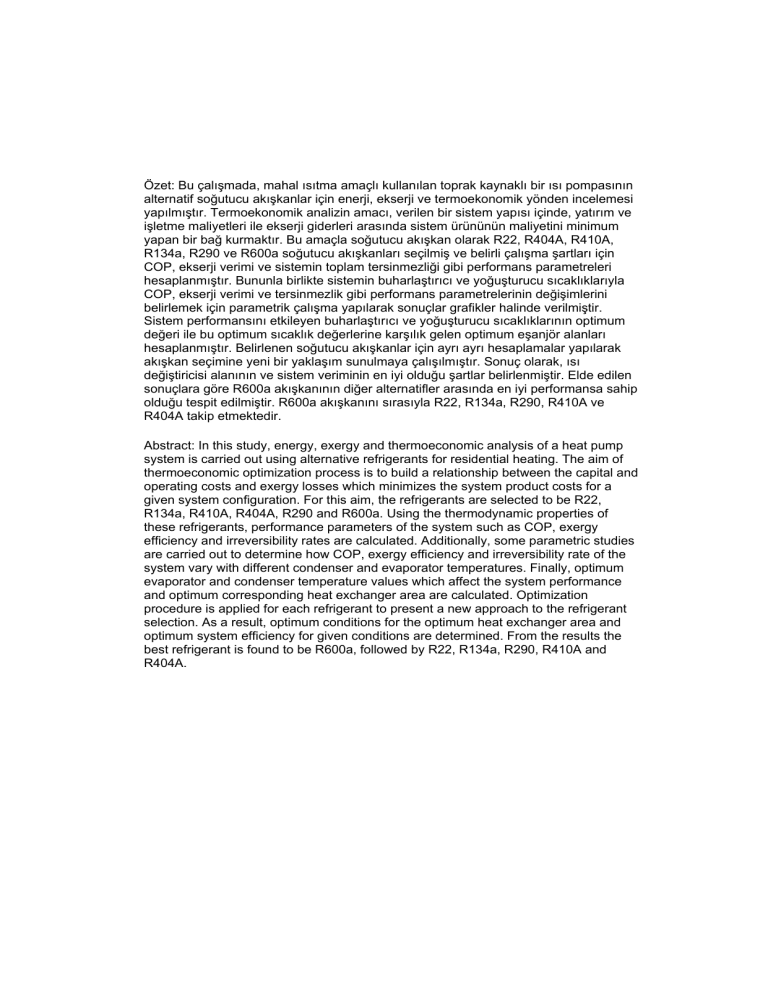Bu çalışmada, mahal ısıtma amaçlı kullanılan toprak kaynaklı bir ısı
advertisement

Özet: Bu çalışmada, mahal ısıtma amaçlı kullanılan toprak kaynaklı bir ısı pompasının alternatif soğutucu akışkanlar için enerji, ekserji ve termoekonomik yönden incelemesi yapılmıştır. Termoekonomik analizin amacı, verilen bir sistem yapısı içinde, yatırım ve işletme maliyetleri ile ekserji giderleri arasında sistem ürününün maliyetini minimum yapan bir bağ kurmaktır. Bu amaçla soğutucu akışkan olarak R22, R404A, R410A, R134a, R290 ve R600a soğutucu akışkanları seçilmiş ve belirli çalışma şartları için COP, ekserji verimi ve sistemin toplam tersinmezliği gibi performans parametreleri hesaplanmıştır. Bununla birlikte sistemin buharlaştırıcı ve yoğuşturucu sıcaklıklarıyla COP, ekserji verimi ve tersinmezlik gibi performans parametrelerinin değişimlerini belirlemek için parametrik çalışma yapılarak sonuçlar grafikler halinde verilmiştir. Sistem performansını etkileyen buharlaştırıcı ve yoğuşturucu sıcaklıklarının optimum değeri ile bu optimum sıcaklık değerlerine karşılık gelen optimum eşanjör alanları hesaplanmıştır. Belirlenen soğutucu akışkanlar için ayrı ayrı hesaplamalar yapılarak akışkan seçimine yeni bir yaklaşım sunulmaya çalışılmıştır. Sonuç olarak, ısı değiştiricisi alanının ve sistem veriminin en iyi olduğu şartlar belirlenmiştir. Elde edilen sonuçlara göre R600a akışkanının diğer alternatifler arasında en iyi performansa sahip olduğu tespit edilmiştir. R600a akışkanını sırasıyla R22, R134a, R290, R410A ve R404A takip etmektedir. Abstract: In this study, energy, exergy and thermoeconomic analysis of a heat pump system is carried out using alternative refrigerants for residential heating. The aim of thermoeconomic optimization process is to build a relationship between the capital and operating costs and exergy losses which minimizes the system product costs for a given system configuration. For this aim, the refrigerants are selected to be R22, R134a, R410A, R404A, R290 and R600a. Using the thermodynamic properties of these refrigerants, performance parameters of the system such as COP, exergy efficiency and irreversibility rates are calculated. Additionally, some parametric studies are carried out to determine how COP, exergy efficiency and irreversibility rate of the system vary with different condenser and evaporator temperatures. Finally, optimum evaporator and condenser temperature values which affect the system performance and optimum corresponding heat exchanger area are calculated. Optimization procedure is applied for each refrigerant to present a new approach to the refrigerant selection. As a result, optimum conditions for the optimum heat exchanger area and optimum system efficiency for given conditions are determined. From the results the best refrigerant is found to be R600a, followed by R22, R134a, R290, R410A and R404A.